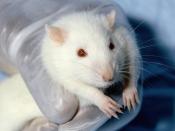ISSUE: For the most part, we would not be able to live very comfortably without them. The question of what is considered proper treatment of animals has been highly debated by groups looking at both the moral and ethical issues of the situation. What exactly is our proper role with regard to non-human creatures? Do they have any rights, or may we do as we please with them? These are questions that politicians all over the world have been arguing about for many years, and still is as controversial as ever!
PROBLEM: How can animal testing benefit both animals and humans without harming the animals?
BACKGROUND: For thousands of years, humans have used animals for a variety of purposes including food, clothing, labor, means of transportation, hunting, medicine, and companionship. However, many personal beauty products, such as lipstick, face cream, anti-perspirant, and laundry detergent all have one major characteristic in common: the suffering and death of millions of animals (Dickinson 13).
Canada has no legislation to protect laboratory animals from any form of mistreatment, abuse, or neglect. Great Britain has nothing in the way of constitutional ethical treatment of laboratory animals. In the United States, the U.S. Welfare Animal Act (passed in 1966 and later amended in 1970 and 1976) charges the U.S. Department of Agriculture with overseeing the humane handling and housing of animals in laboratories, pet dealerships, and exhibitions. While the law covers lab animals (such as rabbits, mice, dogs, and monkeys) it does not state that the animals are to be cared for or to be treated for injuries received from experiments, nor does it state that animals in laboratories can be used for only a limited number of experiments with the least possible suffering and distress (Dickinson 15). In effect then, there is no protection...



A good start.
Although the formatting is not that of a traditional essay, this is excusable. Presumably, this was a requirement of the assignment.
Without knowing the grade level this paper was submitted it, it is difficult to judge the quality precisely. Assuming it is an upper-level high school paper, it deserves its 'green' rating.
1 out of 1 people found this comment useful.